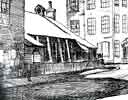 Nottingham Nottingham
St Margaret’s Mission Church
History
St Margaret’s Mission was established by St Saviour’s church in The Meadows to serve the north-eastern part of the parish. In 1884 a small rented room was opened as a Mission Hall. This very quickly proved to be inadequate and larger accommodation was required. This was provided on the upper floors of Walter Danks’ ironmongery shop on London Road. However, by 1891 the shop needed the space for expansion and the mission was forced to look elsewhere for accommodation. The mission was unsuccessful in finding alternative room and was faced with closure until the Bishop of Southwell intervened and purchased a plot of land on the corner of Crocus Street and Wallett Street, only a few yards from the London Road premises. It was a green field site.
A brick mission church and corrugated iron parish room were erected on the plot and opened on 13 February 1892, the cost being met by Archbishop Ridding.
At the time the church was opened the surrounding area was also being developed to meet the growing population of Nottingham. Crocus Street was predominantly terraced housing without gardens. Many of the streets which led off it were given Christian names such as Eugene Street, Mabel Street, Harry Terrace, Mary Terrace and Ernest Terrace.
The district was densely populated, most of the residents being manual workers earning their living in Nottingham Lace Market and other local industrial enterprises. This lower household income was reflected in the financial offerings the congregation was able to make. In 1909 the church records show that the average collection was rarely more than £1. This sum actually fell in 1911 to c.9s. a week. Despite this the church offered a substantial programme of activities and services. Each Sunday started with Communion at 8am, morning service at 10.30am and Evensong at 6.30pm. Sunday School was held at 2.30pm and attracted nearly 300 scholars in 1912. In the same year forty baptisms and 19 confirmations took place. There was also a men’s service at 2.45pm.
In 1910 the church organized a Clothing Club and Provident Club. In 1912 the Sunday School attracted 300 scholars, the priest conducted forty baptisms and submitted 19 candidates for confirmation.
In 1914 church activities included a Young Women’s Institute and Children’s Group, Girl Guides, Ladies’ Working Group and Men’s Institute. The records show that there were no formal parish meetings 1914-18.
In 1940 the church was closed, and soon afterwards requisitioned by the Army for the duration of World War II. It was never reopened. In 1954 it was offered for sale and was demolished. A commercial building was erected on the site. This was extant in 2015 but unoccupied and awaiting redevelopment.
The records of St Margaret’s are housed in the Nottinghamshire Archives. The records of St Saviour’s Church also contain information relating to St Margaret’s.
| 
